Book "the art of hardware architecture: design methods and technologies of digital circuits"
(1) Metastable state
1.1 concept
-
Caused by violation of the set-up time and hold time of the trigger
-
In the window of the rising edge of the clock, the data changes and the output is unknown or metastable
- Metastable window
Metastable window -The larger the window, the higher the probability of entering metastable state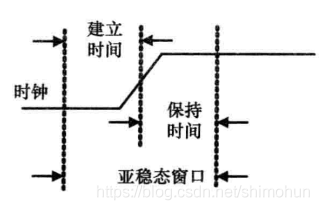
1.2 hazards
-
Output burr
-
It is temporarily unstable and takes a long time to return to stable state
-
Generally, it takes 1 ~ 2 time cycles to return to the steady state
1.3 MTBF
-
Meaning: reciprocal of failure rate
M T B F = e ( t τ / τ ) W f c f d (1.1) MTBF =\frac {e(t_\tau/\tau)} {W f_c~f_d} \\\tag{1.1} MTBF=Wfc fde(tτ/τ)(1.1) -
explain
- t τ t_\tau t τ : the resolution time allowed to exceed the normal transmission delay time of the device
- τ \tau τ : time constant of metastable state (analytical) of trigger
- W W W: Metastable window
- f c f_c fc: clock frequency
- f d f_d fd: asynchronous signal edge frequency
-
Details: omitted
1.4 occurrence scenario
-
As long as the establishment time and holding time are violated, metastability will occur:
- The input signal is asynchronous
- Clock offset / swing (rise / fall time) above tolerance
- The signal operates at two different frequencies or at the same frequency but with different phase and offset
- The combined delay changes the data input of the trigger in the metastable window
-
Metastable state can not be eradicated, but can only reduce the probability of its occurrence
1.5 methods to avoid metastable state
1.5. 1. The clock cycle is long enough
- If the performance is not evaluated, you can ensure that the clock cycle is long enough
- **Clock cycle > quasi steady state resolution time**
- The method is simple, but not practical
1.5. 2 use multi-stage synchronizer
- The first complete clock cycle solves the metastable problem

-
be careful:
An asynchronous signal should not be synchronized by two or more synchronizers, which will lead to the risk that the output of multi-level synchronizer will produce different signals
-
Code: take two-stage synchronizer as an example (common)
Commonly known as "two beats"
//Two stage synchronizer
module demo(
input wire sys_clk,
input wire sys_rst_n,
input wire date_in,
output reg date_out
),
reg date_in_reg0;
reg date_in_reg1;
always @(posedge sys_clk or negedge sys_rst_n) begin
if(!sys_rst_n)
date_in_reg0 <= 1'b0;
else
date_in_reg0 <= date_in;
end
always @(posedge sys_clk or negedge sys_rst_n) begin
if(!sys_rst_n)
date_in_reg1 <= 1'b0;
else
date_in_reg1 <= date_in_reg0;
end
assign date_out = date_in_reg1 ;
endmodule
-
Optimization scheme: multi-stage synchronizer with clock frequency doubling
-
Limitation of the scheme: the limitation of using the above "two beats" is obvious. It takes a long time to respond to asynchronous input signals
-
Solution: double the frequency of the input clock as the clock input of two synchronous flip flops
Frequency doubling of clock with PLL
Multistage synchronizer with clock frequency doubling circuit
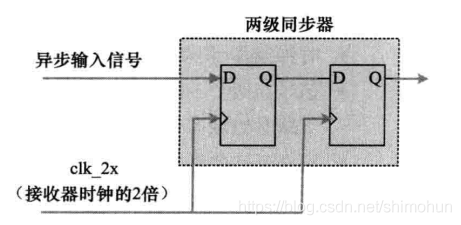
-
The code is as follows:
//Two stage synchronizer module demo( input wire sys_clk, input wire sys_rst_n, input wire date_in, output reg date_out ), reg date_in_reg0; reg date_in_reg1; always @(posedge sys_clk_2x or negedge sys_rst_n) begin if(!sys_rst_n) date_in_reg0 <= 1'b0; else date_in_reg0 <= date_in; end always @(posedge sys_clk_2x or negedge sys_rst_n) begin if(!sys_rst_n) date_in_reg1 <= 1'b0; else date_in_reg1 <= date_in_reg0; end assign date_out = date_in_reg1; pll pll_inst( .clk_in (sys_clk ), .c0 (sys_clk_2x ) ); endmodule
-
1.5. 3 type of synchronizer
1. High frequency → \rightarrow → low frequency
Method I:
-
Circuit diagram
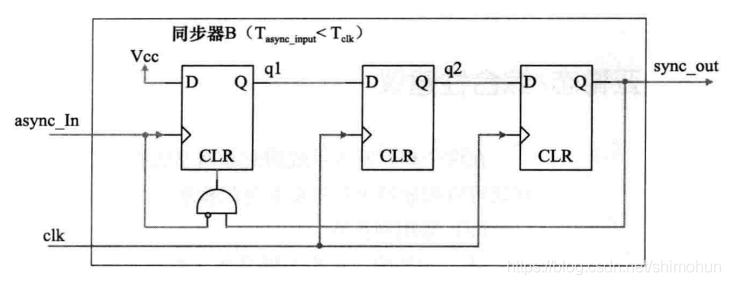
Description: inputs D and D of the first stage trigger V c c V_{cc} Vcc} is connected, and the clock signal is an asynchronous input signal. The other two flip flops are controlled by the system time (clk). A total of short pulses make q1 become a high level, which is output from sync_out after two clock (clk) edges
-
Sequence diagram
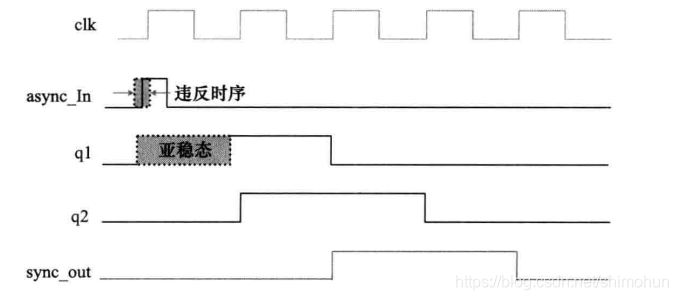
-
code
module demo ( input wire sys_clk, input wire sys_rst_n, input wire clk_h, //High speed clock, not used in this demo input wire clk_l, //Low speed clock, i.e. clk in the figure input wire async_in, output reg sync_out ); //------------------------wire & reg-------------------// //reg1 reset signal high level reset low level normal operation wire reg1_clr; reg q1; reg q2; //-------------------------mian------------------------// //reg_clr signal assign reg1_clr = (!async_in) && sync_out; //reg1 always @(posedge async_in or posedge reg1_clr) begin if(reg1_clr == 1'b1) q1 <= 1'b0; else q1 <= 1'b1; //VCC in the figure end //reg2 always @(posedge clk_l) begin q2 <= q1; end //sync_out output always @(posedge clk_l) begin sync_out <= q2; end endmodule
Method 2:
-
Thought:
Because it is high frequency → \rightarrow → low frequency, there may be signals in the high-frequency clock domain, and the clock in the low-frequency clock domain cannot be collected
Therefore, it is necessary to broaden the signal model in the high-frequency clock domain, so that the signal acquisition in the low-frequency clock domain can be obtained
Note: signal_b feedback to the high frequency clock domain is also cross clock domain, which also needs to be processed
-
method:
Pulse signal plus_ A at clk_h is widened to become level signal_a. Re clk_l pass, when confirming clk_l clear the signal after the "see" signal has been synchronized_ a. The implementation method is still * * "collect - take two shots - synchronize" *
-
code
module demo( input wire clk_h, input wire clk_l, input wire sys_rst_n, input wire pulse_a_in, output wire pulse_b_out, output wire b_out ); //---------------- wire & reg ---------------------// reg signal_a; reg signal_b; reg signal_b_r1; reg signal_b_r2; reg signal_b_a1; reg signal_b_a2; //---------------- mian --------------------------// //CLK in clock domain_ H, generate the widening signal_a always @(posedge clk_h or negedge sys_rst_n) begin if(!sys_rst_n) signal_a <= 1'b0; else if(pulse_a_in == 1'b1) //Input signal pulse detected_ a_ If in is pulled high, signal is pulled high_ a signal_a <= 1'b1; else if(signal_b_a2 == 1'b1) //Signal detected_ b1_ If A2 is pulled high, signal is pulled low_ a signal_a <= 1'b0; else signal_a <= signal_a; end //CLK in clock domain_ L, collect signal_a. Generate signal_b always @ (posedge clk_l or negedge sys_rst_n)begin if (!sys_rst_n) signal_b <= 1'b0; else signal_b <= signal_a; end //Multi level trigger processing (two levels here) always @ (posedge clk_l or negedge sys_rst_n)begin if (!sys_rst_n) begin signal_b_r1 <= 1'b0; signal_b_r2 <= 1'b0; end else begin signal_b_r1 <= signal_b; //Yes, signal_b take two shots signal_b_r2 <= signal_b_r1; end end //CLK in clock domain_ Under a, collect signal_b_r1, used for feedback to pull down the spread signal_a always @ (posedge clk_h or negedge sys_rst_n) begin if (!sys_rst_n) begin signal_b_a1 <= 1'b0; signal_b_a2 <= 1'b0; end else begin signal_b_a1 <= signal_b_r1; //Yes, signal_b_r1 takes two beats because it also involves cross clock domain signal_b_a2 <= signal_b_a1; end end assign pulse_b_out = signal_b_r1 & (~signal_b_r2); assign b_out = signal_b_r1; endmodule
2. Low frequency → \rightarrow → high frequency
-
There is no problem that the signal cannot be collected from low-frequency signal to high-frequency signal. Therefore, the method of two beats can be directly used for detection
-
code
// The code directly adopts the code of multi-level synchronizer
-
A special case - the output signal in the low frequency domain is generated by combinatorial logic
-
Circuit diagram
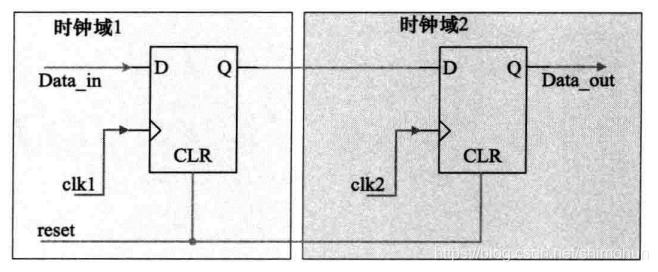
explain:
- Clock domain 1 is a low-frequency clock domain, and clock domain 2 is a high-frequency clock domain
- Data_in is generated by combinatorial logic, i.e. assign
- The shaded part of clock field 2 represents a multi-level synchronizer
-
code
module demo( input wire clk_l, input wire clk_h, input wire sys_rst_n, input wire date_in, output reg date_out ); reg date_l; reg date_h_0; reg date_h_1; //The signal of combinational logic first passes through the clock synchronization of low clock domain always @(posedge clk_l or negedge sys_rst_n) begin if(!sys_rst_n) date_l <= 1'b0; else date_l <= date_in; end //Date in high clock domain_ In synchronization always @(posedge clk_h or negedge sys_rst_n) begin if(!sys_rst_n) begin date_h_0 <= 1'b0; date_h_1 <= 1'b0; end else begin date_h_0 <= date_l; date_h_1 <= date_h_0; end end assign date_out <= date_h_1; endmodule -
1.6 Summary - reducing metastability
It is clear that metastability is unavoidable and can only reduce the probability of metastability
The following are several methods to reduce the probability of metastable state
- Using synchronizer
- Trigger with faster response (shorten metastable window) T w T_w Tw)
- Metastable hardening flip-flop is adopted (specially designed for high bandwidth and reducing the sampling time optimized for clock domain input circuit)
- Cascade trigger is used as synchronizer
- The probability of metastable failure of a common trigger is P P P. Then N N The probability of metastable failure of N flip flops is P N P^N PN
- Reduce sampling rate
- Avoid using d V / d t dV/dt Input signal when dV/dt is low